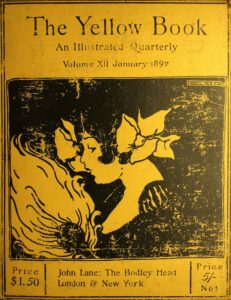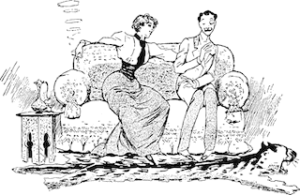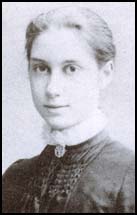A Feminist Fairytale: Evelyn Sharp’s “The Restless River”
© Krystal Cusma, Ryerson University 2018
INTRODUCTION

The 1890s was a decade of great cultural change. During this time feminist groups arose, dissident ideas about sexuality emerged, and non-conforming literature and artwork started to appear (Kooistra). Although many people in society tried to suppress these ideas, magazines such as The Yellow Book started to showcase these ideas in an artistic way, and they were not silenced. This magazine started in 1894 by Henry Harland and Aubrey Beardsley and ran for thirteen issues released quarterly, ending in 1897(Kooistra). Volume twelve, released in January 1897 contained a feminist fairytale called “The Restless River”, written by children’s author and feminist Evelyn Sharp.
Although disguised as an ordinary fairytale, “The Restless River” appeals to not just children but also an adult audience due to its feminist undertones. Contrary to Harris’ claim that Sharp did not “focus on social issues” (Harris, 295 ) in her six short stories published to The Yellow Book, Sharp did use the fairytale “The Restless River” to reinvent her feminist ideas. By doing this, she commented on and critiqued the societal ideals and pressures for women at the time.
FEMINISM AND THE NEW WOMAN IN THE 1890S
In the 1890s, Britain was still a very patriarchal society (Ledger, 9). Women were to stay uneducated, get married to British men, and become mothers(Ledger, 19). Many women started to become irritated due to the constraints that they had, so they decided to spread their ideas about feminism to other people in hopes of gaining some equality to men (Ledger, 11). The term “New Woman” came into existence, and it meant a woman whose ideas did not conform to those of the patriarchal hegemony. This could mean that she worked, or lived alone, or did not have any children. Evelyn Sharp and many other female writers decided to write feminist literature to spread their views(Ledger, 94).
Of course, many people were opposed to the New Women. The entire British Empire was built upon ideas of masculinity and had always been a society that favoured males (Ledger, 94). The majority of people thought that the new women movement was a threat to tradition, and that feminists sought out to emasculate men (Ledger, 95). What the new woman movement was really trying to do was create a more inclusive society for women. They wanted the same rights as men, such as the right to vote and earn a university degree. However, the societal criticism of the new women did not silence them as they continued to publish feminist works, even when society labeled them as “mannish” (Ledger, 96).
Some of the main goals of the new women were to attack the traditional institution of marriage, and lack of reproductive rights, as it was very taboo for a woman to not be married or have no desire to have children(Ledger, 95). The new women wanted to attack the institution of marriage since is oppressed their freedom. Some new women did not want to go through motherhood, because if a woman had children, she would not be able to work nor go to school (Ledger, 10).
Magazines such as The Yellow Book published works by feminist authors because it was not concerned with being well perceived by the public (Kooistra). Instead, platforms like these magazines gave people a chance to publish their work, because they would not have been able to in the other platforms. The point of these magazines was to be different and include art that would be seen as outlandish; yet still the magazine was very popular and very revolutionary (Kooistra). The front cover and title page on the twelfth volume of The Yellowbook was designed by an American female artist named Ethel Reed. This shows that the magazine was not only open to publishing work created by a female, but also a foreigner who was able to get her work published because of this inclusive magazine.
“THE RESTLESS RIVER”- A FEMINIST FAIRYTALE
During the 1890s, the short story was popularized, so many authors such as Sharp used them to convey an idea since many people liked to read them (Chan, x). Sometimes authors would use the fairytale, folklore, or fantasy genre as a vehicle to deliver that idea exactly how they wanted to. Often times, fairytales teach lessons to younger readers because they involve magical elements that peek a young reader’s interest. The way that authors deliver their message or idea is transformed using the author’s imagination to reinvent the idea in an interesting and entertaining way (Sumpter, 157). In the case of “The Restless River”, Sharp reinvents the idea to showcase her thoughts on patriarchal society, and feminism. Because the fairytale genre does not have to be realistic, Sharp is able to explore a world much different than her own. In this tale, a very headstrong queen rules the land of Nonamia. She makes all of the decisions for her kingdom and her family; especially for

her son, the Prince. The fairytale trope of royalty is used to demonstrate power, particularly power of the female. Although, the queen is not idealized. Sharp does not describe her as a perfect person, instead she describes her as “not even beautiful” and someone who can be condescending, and controlling. By doing this, Sharp is not telling her audience that women are perfect and should be all powerful in society, but there should be some balance in the way that society is ran.
The Queen orders her son a fairy godfather instead of a fairy godmother because she wants to remain in power. She believes that if she had given her son a fairy godmother, she would try to steal her power. Sharp uses this to switch the roles of males in females that are demonstrated in her own society. In Sharp’s reality, men have all of the power, and they are afraid that women will try to take that power away from them when they speak out against the injustices they face. Sharp is showing the audience a role reversal in order for them to imagine a world where the women rule most everything, while the men just like the Queen’s husband, are meek. The King follows his wife’s orders and has very little governing power. The reason Sharp constructs the King as a meek character is to explore the idea of a male being oppressed and silenced in society rather than a female. Sharp does this to allow society to realize and imagine how women are excluded from society and expected to follow orders, and how unjust it is. In Sharp’s society, if a woman is being silenced or controlled it is not out of the ordinary, but since the roles are reversed in this story, her intentions will be made clear and stand out to the audience.
The fairy godfather appears for the Prince’s christening and prophesies that the Prince will marry a woodcutter’s daughter; The Restless River. The Queen is upset by this and orders all of the woodcutter’s daughters to be executed. A woodcutter brought his baby daughter forth and put her in the Sluggish Brook which immediately turns rapid and becomes the Restless River. The Queen wanted total control of her son’s life and wanted him to marry a princess. This is why she ordered all of the woodcutter’s daughters be executed in hopes the prophecy will not come true. This is another way that the Queen is not idealized. She is shown as overly controlling. Sharp does this again to show how women in her society feel controlled by men, and they are not allowed to choose their destiny for themselves, but by the men who govern their lives, just like how the Queen is trying to control her son’s destiny.
The Prince grows up inside of the palace walls and receives no education. He does not know how to read nor write. He longs for adventure, but his mother insists that he stays inside the palace. The significance of this aspect of the story is to show the oppression that the women in this era face in terms of education. They are kept ignorant so that they have to stay at home, just like the Prince. The Queen is also sheltering her son from exploring himself and finding love on his own by trapping him in the palace. She even tries to force him to pick a princess to wed. This signifies the lack of opportunity that women had to explore the world and discover things for themselves since society pressured them to become married and go through motherhood.
Upon seeing The Restless River from a tower in the palace, the Prince is immediately interested by it and claims that it is all that he has ever

wanted. The King lets him go to see it. There he sees a beautiful girl that he wishes to marry- she is the woodcutter’s daughter. An interesting thing about this story is that the Prince is the one that pursues a love interest rather than the female. A common fairytale element is the female falling in love with a man and doing everything that she can to be with him. This twist is purposely made by Sharp to reverse the roles again, since many fairytales are centred around the woman pursuing the prince at whatever cost. The significance of this detail is empowerment of women, since being the one who is pursued is seen as having more power, or even more dignity than the one who is doing the pursuing.
Surprisingly, the Queen lets the Prince and the woodcutter’s daughter marry, approving their relationship. Instead of being someone who thwarts the Prince’s happiness, she allows it. Sharp shows the audience that allowing the oppressed to make their own decisions and lead their own lives is not harmful, and the change can be positive. If society allows women to make their own decisions, men will not be harmed by it or emasculated like they thought, but rather there will be equality, and everyone can be contempt.
CONCLUSION
“The Restless River” cleverly reverses the expected roles of men and women in the 1890s to let the readers imagine this fictional world. It does so, with the element of reinvention and the fairytale in order to convey a complex theme in an easily understandable way. Sharp does not demonize or emasculate men, and also does not glorify or idealize women. Because of these attributes, her story promotes equality between men and women, while remaining entertaining but enlightening.
Works Cited
Chan, Winnie. The Economy of the Short Story in British Periodicals of the 1890s. Routledge, 2014.
Harris, Wendell. “H. W Nevinson, Margaret Nevinson, Evelyn Sharp: Little Known Writers and Crusaders.” English Literature in Transition. Vol. 45, no. 2002, pp. 280.
Kooistra, Lorraine Janzen. “The Yellow Book (1894-1897): An Overview.” The Yellow Nineties Online. Ed. Denmnis Denisoff and Lorraine Janzen Kooistra. Ryerson Univeristy, 2012. Web. [November, 20 2018]
Ledger, Sally. The New Woman: Fiction and Feminism at the Fin De Siècle. Manchester University Press, 1997.
Sumpter, Caroline. The Victorian Press and the Fairy Tale. Palgrave Macmillan, 2012.
Images in this online exhibit are either in the public domain or being used under fair dealing for the purpose of research and are provided solely for the purposes of research, private study, or education.
